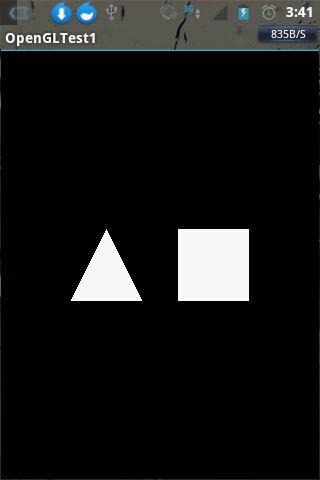openGL ES 学习第一课(绘制三角形和四边形)
openGL ES主要是用于嵌入式设备的3D图形的绘制
GLSurfaceView GLSurfaceView.Renderer
效果如下:
直接代码:
1、GLRender.java
package wu.demo.www;
import java.nio.IntBuffer;
import javax.microedition.khronos.egl.EGLConfig;
import javax.microedition.khronos.opengles.GL10;
import android.opengl.GLSurfaceView.Renderer;
public class GLRender implements Renderer {
int one = 0x10000;
//三角形的三个顶点
private int[] triggerBuffer = {
0, one, 0, //上顶点
-one, -one, 0, //下左
one, -one, 0, //下右
};
private int[] quaterBuffer = {
-one, one, 0,
one, one, 0,
-one, -one, 0,
one, -one, 0
};
private IntBuffer getVertexBuffer(int capacity, int sum[]) {
IntBuffer vertexBuffer = BufferFactory.createIntBuffer(capacity).put(sum);
vertexBuffer.position(0);
return vertexBuffer;
}
public void onDrawFrame(GL10 gl) {
//清除屏幕和深度缓存
gl.glClear(GL10.GL_COLOR_BUFFER_BIT | GL10.GL_DEPTH_BUFFER_BIT);
gl.glLoadIdentity();
//移动顶点,左移1.5,向里6个单位
gl.glTranslatef(-1.5f, 0.0f, -6.0f);
//移动好了后,设置顶点
gl.glEnableClientState(GL10.GL_VERTEX_ARRAY);
//绘制三角形
gl.glVertexPointer(3, GL10.GL_FIXED, 0, getVertexBuffer(9, triggerBuffer));
gl.glDrawArrays(GL10.GL_TRIANGLES, 0, 3);
//重置观察矩阵
gl.glLoadIdentity();
//移动顶点,移动到右边
gl.glTranslatef(1.5f, 0f, -6f);
//绘制四边形
gl.glVertexPointer(3, GL10.GL_FIXED, 0, getVertexBuffer(12, quaterBuffer));
gl.glDrawArrays(GL10.GL_TRIANGLE_STRIP, 0, 4);
//取消顶点设置
gl.glDisableClientState(GL10.GL_VERTEX_ARRAY);
}
public void onSurfaceChanged(GL10 gl, int width, int height) {
float ratio = (float) width / height;
gl.glViewport(0, 0, width, height);
//设置投影矩阵
gl.glMatrixMode(GL10.GL_PROJECTION);
//重置投影矩阵
gl.glLoadIdentity();
gl.glFrustumf(-ratio, ratio, -1, 1, 1, 10);
gl.glMatrixMode(GL10.GL_MODELVIEW);
gl.glLoadIdentity();
}
public void onSurfaceCreated(GL10 gl, EGLConfig config) {
//告诉 系统对透视进行修正
gl.glHint(GL10.GL_PERSPECTIVE_CORRECTION_HINT, GL10.GL_FASTEST);
//白色背景
gl.glClearColor(0, 0, 0, 0);
//启用阴影平滑
gl.glShadeModel(GL10.GL_SMOOTH);
//设置深度缓存
gl.glClearDepthf(1.0f);
//启用深度测试
gl.glEnable(GL10.GL_DEPTH_TEST);
//所做深度测试 的类型
gl.glDepthFunc(GL10.GL_LEQUAL);
}
}
package wu.demo.www;
import java.nio.ByteBuffer;
import java.nio.ByteOrder;
import java.nio.FloatBuffer;
import java.nio.IntBuffer;
import java.nio.ShortBuffer;
/**
* A utility class to create buffers.
*
* All public methods are static. The Singleton pattern was avoided to avoid concerns about
* threading and the Android life cycle. If needed, It can be implemented later given some research.
*/
public class BufferFactory {
// This class cannot and should not be instantiated
private BufferFactory() {}
// We use Buffer.allocateDirect() to get memory outside of
// the normal, garbage collected heap. I think this is done
// because the buffer is subject to native I/O.
// See http://download.oracle.com/javase/1.4.2/docs/api/java/nio/ByteBuffer.html#direct
/**
* Creates a buffer of floats using memory outside the normal, garbage collected heap
*
* @param capacity The number of primitives to create in the buffer.
*/
public static FloatBuffer createFloatBuffer(int capacity) {
// 4 is the number of bytes in a float
ByteBuffer vbb = ByteBuffer.allocateDirect(capacity * 4);
vbb.order(ByteOrder.nativeOrder());
return vbb.asFloatBuffer();
}
/**
* Creates a buffer of shorts using memory outside the normal, garbage collected heap
*
* @param capacity The number of primitives to create in the buffer.
*/
public static ShortBuffer createShortBuffer(int capacity) {
// 2 is the number of bytes in a short
ByteBuffer vbb = ByteBuffer.allocateDirect(capacity * 2);
vbb.order(ByteOrder.nativeOrder());
return vbb.asShortBuffer();
}
public static IntBuffer createIntBuffer(int capacity) {
ByteBuffer vbb = ByteBuffer.allocateDirect(capacity * 4);
vbb.order(ByteOrder.nativeOrder());
return vbb.asIntBuffer();
}
}
3、OpenGLTest1Activity.java
package wu.demo.www;
import android.app.Activity;
import android.opengl.GLSurfaceView;
import android.opengl.GLSurfaceView.Renderer;
import android.os.Bundle;
public class OpenGLTest1Activity extends Activity {
/** Called when the activity is first created. */
@Override
public void onCreate(Bundle savedInstanceState) {
super.onCreate(savedInstanceState);
Renderer render = new GLRender();
GLSurfaceView glView = new GLSurfaceView(this);
glView.setRenderer(render);
setContentView(glView);
}
}
